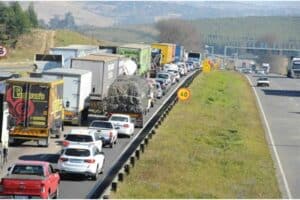Experts from various sectors met to develop EW4All, improving early warning systems for South Africa’s hazardous weather risks.

Experts from various departments and the private sector met to come up with an Early Warnings for All (EW4All) as South Africa continues to rank among the Southern African countries that are vulnerable to hazardous weather events.
The workshop was hosted by various representatives from the National Disaster Management Centre, South African Weather Service, the department of Water and Sanitation, the Council for Geoscience, the Independent Communications Authority of South Africa and UN and international organisations active in early warning systems as well as private companies.
Hazardous weather events
The Deputy Minister of Forestry, Fisheries and the Environment, Bernice Swarts, said the national consultative workshop on EW4All was essential in disaster management of hazardous weather events, including severe floods, droughts, tropical cyclones, storms and heat waves.
Swarts said the floods in Durban, KwaZulu-Natal, in April 2022 claimed nearly 500 lives, destroyed homes, displaced 40 000 people, temporarily left 45 000 jobless and inflicted infrastructural as well as economic damage worth an estimated R17 billion.
“As we speak there are many families whose loved ones remain unaccounted for. Some of those affected have spoken of how they struggle to find closure because their loved ones have not been [declared] dead,” she said.
Swarts described EW4All as a groundbreaking initiative to ensure that everyone on earth was protected from hazardous weather, water, or climate events through life-saving early warning systems by the end of 2027.
“South Africa is counted among the countries severely impacted by natural hazards and would therefore need to ensure that it mounts a solid defence to counter them,” she said.
Weather alert: Orange level 6 warning for damaging winds and runaway fires
Early warning systems have return on investment
Swarts said the 2019 Global Commission on Adaptation flagship report, Adapt Now, found that early warning systems provided more than a tenfold return on investment and that just 24 hours warning of a coming storm or heatwave could cut the ensuing damage by 30% and spending $800 million (about R14.5 billion) on such systems in developing countries would avoid losses of $3-16 billion per year.
South African Weather Service CEO Ishaam Abader said the early warnings for all initiative had been a buzzword within the meteorology community after the United Nations secretary-general Antonio Guterres, unveiled the campaign on World Meteorological Day in 2022.
“The people of the Western Cape have barely caught their breath following the floods that visited their province recently, causing untold devastation.”
The community of oThongathi in Durban, KwaZulu-Natal, was also picking up the pieces and rebuilding their lives, following the freak tornado that hit the area recently, opening the old wounds of the April and May 2022 disaster.
Abader said the aim of the workshop was for stakeholders to come up with an action plan.
ALSO READ: Ramaphosa finds pen and signs Climate Change Bill into law






